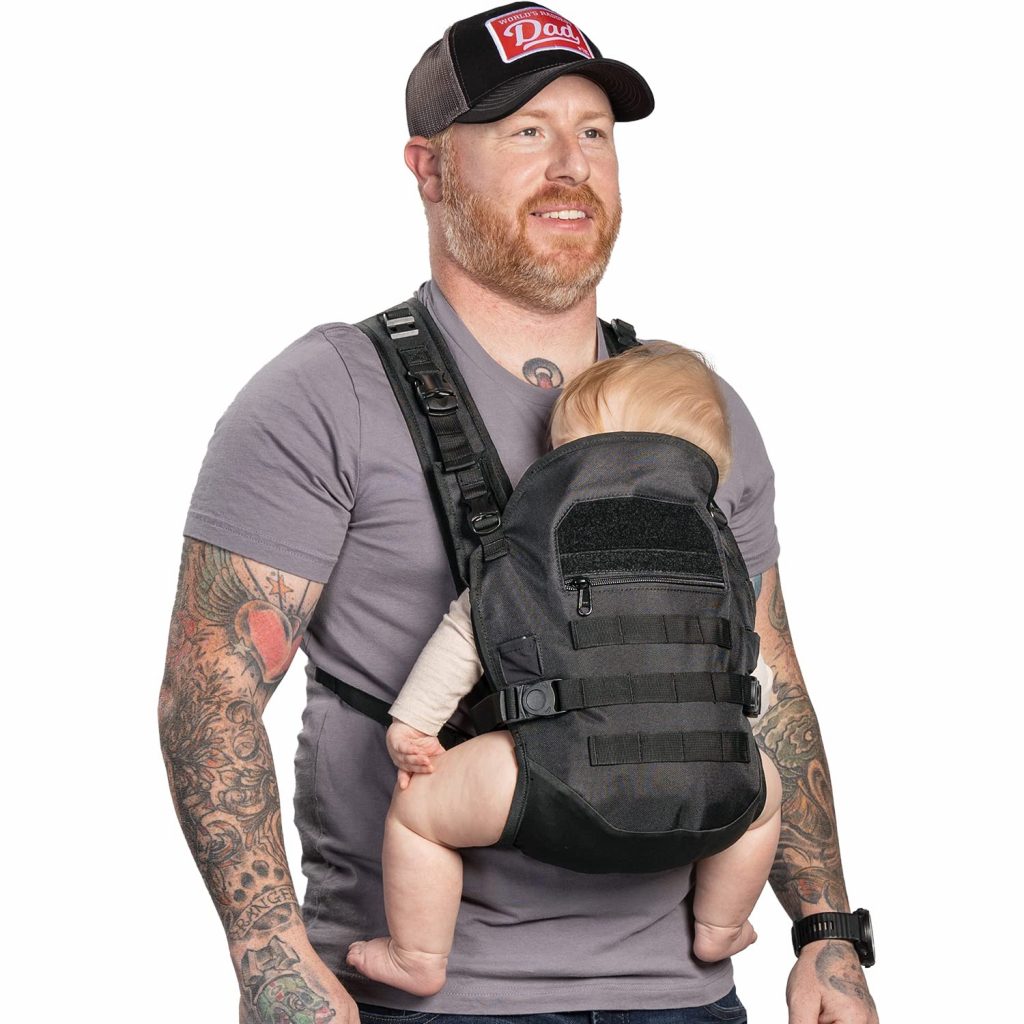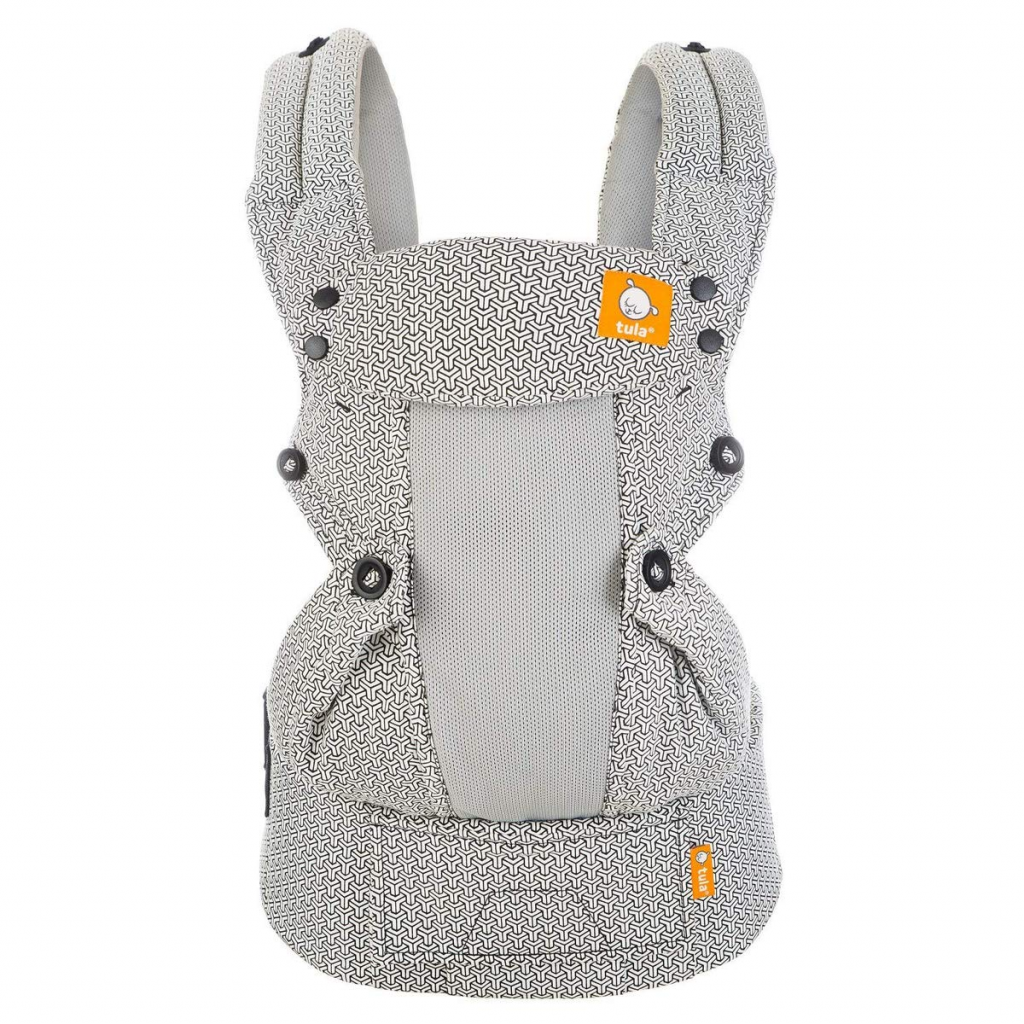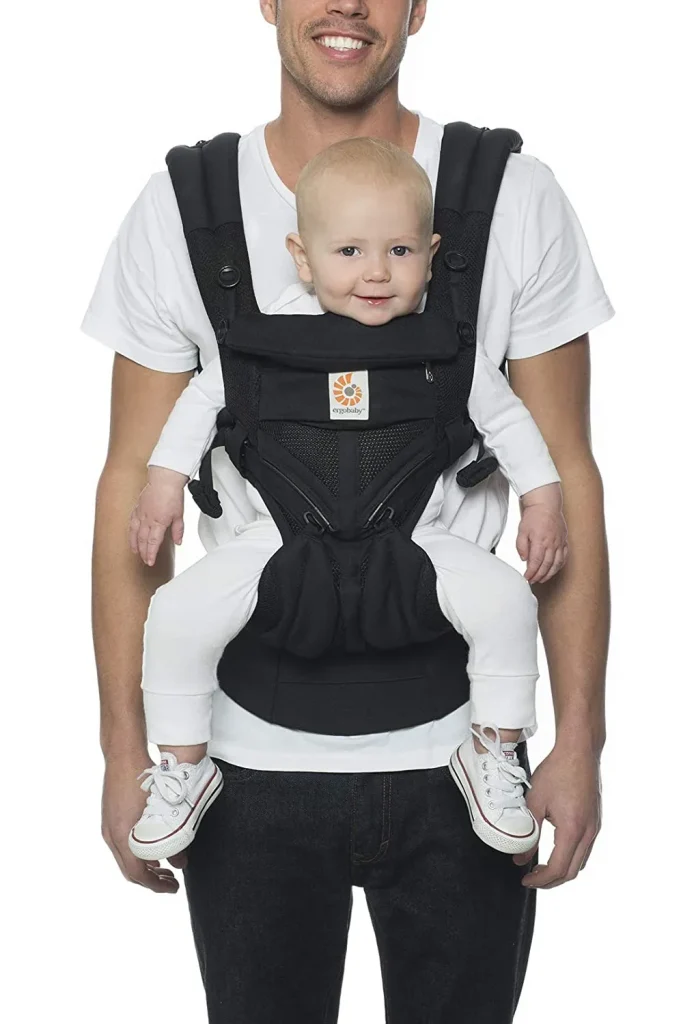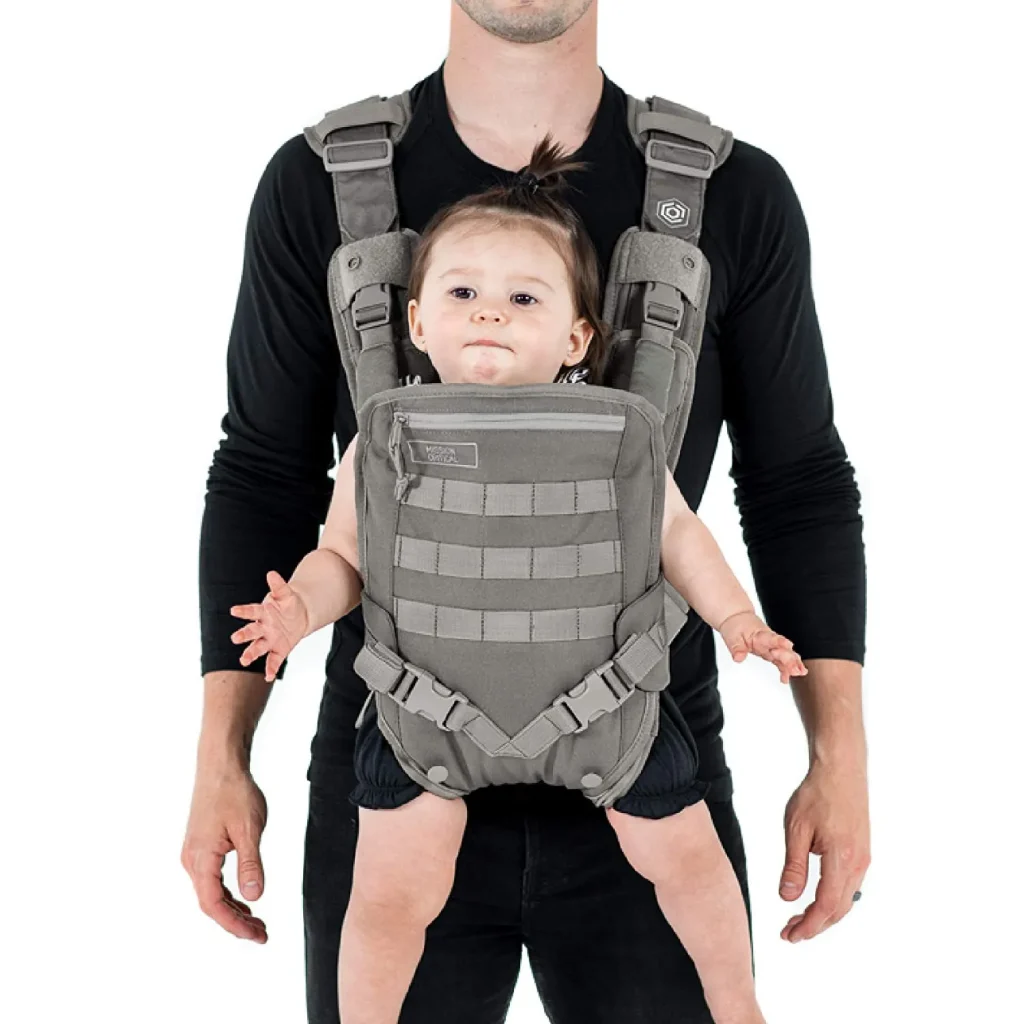Products Reviewed:
Best Budget: Bbpark Mesh Baby Carrier Newborn to Toddler
Best For Newborns: Ergobaby Omni 360 All-Position Baby Carrier
Best For Larger Dads: TBG – Men’s Tactical Baby Carrier
Best For Tall Dads: Mission Critical S.01 Action Baby Carrier
Best Splurge: Baby Tula Coast Explore Mesh Baby Carrier
Best Overall: Ergobaby 360 All-Position Baby Carrier with Lumbar Support
Baby carriers are a popular choice for dads who want to keep their little ones close while still being able to go about their daily tasks. Not only do they provide a convenient way to carry your baby, but they also offer a sense of security and bonding that is hard to replicate with other baby gear.
When it comes to choosing the best baby carriers for dads, men have specific needs that should be considered. The carrier should be comfortable for both dad and baby, provide various carry positions, and have a suitable weight capacity. Additionally, dads may prefer a carrier that is designed with a masculine aesthetic and is easy to use.
One popular option for dads is the tactical baby carrier, which is designed to be sturdy, durable, and equipped with numerous features to make babywearing more convenient. However, not all dads want or need a tactical carrier, and you can find an affordable baby carrier with some research, one that provides the comfort and support your baby needs without breaking the bank.
In this article, we’ll explore some of the best baby carriers for dads, including tactical and non-tactical options. We’ll look at their features, carry positions, weight capacity, and price to help you choose the best baby carrier for you and your little one.
Whether you’re looking for a carrier that’s cool and stylish or one that’s simple and functional, we’ve got you covered. So, let’s get started and find the best baby carrier for you and your family.
How We Choose
Choosing the appropriate soft-structured baby carrier can significantly enhance the experience of babywearing for dads. To find the ideal carrier for dads, it’s crucial to seek out specific features that guarantee both parent and child’s comfort.
Hip-Healthy Designation: A carrier that promotes healthy hips utilizes a supportive seat position for infants who are under six months old. This seat position ensures that the baby’s hips and legs are adequately supported in the “M” position, which is critical for healthy hip development. Opting for a carrier with a supported seat position can help prevent hip dysplasia and provide a comfortable and secure experience for both the parent and the child. This position ensures their growing hips have the ideal support. It is also more comfortable for parents.
Adjustable Shoulder Straps: Men tend to have broader shoulders than women. So go for wide shoulder straps that are easy to put on and not cause discomfort across your back or neck. Padded shoulder straps are a must.
Long Waist Belt: Baby carriers should buckle around your natural waist, not your hips. Look for a carrier’s waistband length that can accommodate your size.
Lumbar Support: If you intend to wear your child for extended periods of time, look for a carrier that includes a lumbar support panel on the waistband.
Breathable Fabrics: Consider selecting a fabric that is breathable and appropriate for your activity level and climate. In hot and humid environments, opt for carriers made with breathable mesh fabric to enhance air circulation and prevent your baby from overheating. For cooler climates or indoor use, cotton or polyester twill fabrics are sturdy, easy to clean, and suitable for machine washing. By choosing the right fabric, you can ensure your baby stays comfortable and content while you both enjoy your adventures.
Versatile Positions: Seek a carrier that offers you the flexibility to carry your child forward-facing, as well as on your back or hip. This provides you with more options for your child’s comfort and your convenience as you go about your daily tasks. Being able to switch between carrying positions can also help prevent discomfort or fatigue, both for you and your child. When selecting a carrier, consider the range of carrying positions it offers to ensure it meets your needs and preferences. Adjustable head support and separate infant insert are huge pluses.
Newborn to Toddler Weight Range: Look for a carrier that you can comfortably wear from newborn to toddler.
After reading thousands of reviews on Amazon, here are the best baby carrier for dads we recommend
Best Budget
Bbpark Mesh Baby Carrier Newborn to Toddler
Why We Love It
Lightweight, and comfortable for many body types, the Bpark is one of those soft structured carriers that check most of the boxes for safety, comfort and most importantly budget. The well-designed 3D mesh is amazingly breathable for the baby. It also keeps you and your baby cooler even in warm weather. It’s easy to switch between several front and back positions with the growth of your baby. All without breaking the piggy bank.
What You Should Know
The baby carrier is suitable for infants to toddlers with 7.5-33Lbs. The edge of the Kangaroo baby body carrier is filled with thick padding with seat, which can effectively avoid injuries to the baby’s legs from scratches.
Widened shoulder straps and padded waist belt of baby carrier distribute the weight reasonably. Detachable bib on both sides of the shoulder straps are designed to comfort the baby. A convenient pocket allows you to take out the tissue at any time.
Upgraded safety buckle is different from the traditional slack buckle to ensure that the baby backpack carrier is tied nicely and snugly to you. The tuckaway hood will protect your baby from the scorching sun. It is perfect for hiking or traveling in all seasons and definitely lighter on the pocket than other baby carriers.
Best For Newborns
Ergobaby Omni 360 All-Position Baby Carrier
Why We Love It
The Ergobaby Omni is a great baby carrier and can be used in all carrying positions including inward, forward, back & hip and adapts from newborn to toddler. Padded lumbar support waist belt provides maximum lower back comfort. It also includes extra padded shoulder pads. Adjustable bucket seat supports baby in an ergonomic natural “M” position in all carry positions.
What You Should Know
This fits babies from 0-48 months (7-45lbs). This baby carrier was acknowledged as hip-healthy by the International Hip Dysplasia Institute. It includes large storage pouch & UPF 50+ tuck away baby hood for sun and wind protection.
You have the option to wear 2 ways: crossed or “backpack style”. Waist belt can be worn high or low to maximize comfort.
Cool Air Mesh fabric is soft for baby, yet durable, to keep you cooler in warm weather. Innovative sliders effortlessly allow you to switch baby from inward to forward mode quickly and easily.
This carrier adjusts to fit a wide variety of body types, with a waist that extends to 55 inches.
Best For Larger Dads
TBG – Men’s Tactical Baby Carrier

Why We Love It
Proven to provide a comfortable fit by customers over 6’5″, 270lbs, the TBG – Men’s Tactical Baby Carrier is a MOLLE-compatible baby carrier. And as with the best baby carriers for dads, it designed for customization with pouches and carabiners.
Simplistic, secure cross-strap design distributes weight evenly, reducing strain and making it easy to wear a diaper bag with the carrier. The padded straps are incredibly comfortable on the shoulders. Open back design minimizes heat discomfort when worn for long periods. It has easy to adjust UTX buckles for babies and toddlers 8 to 33 pounds.
What You Should Know
This baby carrier is built to last. Crafted from high-end materials, including 600D tactical polyester and premium hardware, the Tactical Baby Carrier 2.0 stands up to regular use without sacrificing comfort.
The wide base provides ample hip support while a removable, machine-washable cotton liner gently cushions the interior. Criss-crossed, air mesh padded shoulder straps distribute weight evenly, keeping it primarily off the shoulders.
Among the practical features of the carrier, MOLLE webbing and a zipper pocket on the front give you fast access to daily necessities without the hassle of removing a diaper bag and disturbing your sleeping baby.
It meets safety requirements for baby carriers (ASTM and CPSIA) and features wide, comfort-stretch bottom to support baby’s hips. This was also certified as hip-healthy by the International Hip Dysplasia Institute.
Best For Tall Dads
Mission Critical S.01 Action Baby Carrier
Why We Love It
This tactical-style infant and toddler carrier is easy to put on and easy to adjust so tall dads never have to sacrifice comfort or mobility. With front and back panels that include tough MOLLE webbing, this carrier is highly customizable and is known to fit even 6’5” tall customers comfortably.
For maximum convenience and utility, this carrier pairs with Mission Critical’s S.01 Action Daypack to give you even more carrying capacity and to maintain balanced weight distribution for ultimate comfort.
What You Should Know
The S.01 Action Baby Carrier seat is designed for babies approximately 8–35 lbs. Made from super-strong, durable 1000D nylon construction and heavy-duty padded straps, this carrier will keep your most precious cargo safely in tow.
The waist strap expands to a maximum of 64 inches. Other features such as the breathable staircase air mesh, stowable sun shield, and removable cotton, washable liner make this carrier a must-have on any adventure.
Best Splurge
Baby Tula Coast Explore Mesh Baby Carrier

Why We Love It
As the best splurge option, the Baby Tula Coast Explore Mesh Baby Carrier offers several premium features that most others don’t.
First, the carrier is made of lightweight, breathable mesh fabric, making it ideal for hot or humid climates. The carrier also features a supportive waistband and adjustable shoulder straps, providing a comfortable fit for parents of different sizes. Additionally, the carrier has multiple carrying positions, including front-facing, back, and hip carry, allowing you to choose the position that works best for you and your baby.
The carrier also has a weight limit of up to 45 pounds, which means it can be used for an extended period as your baby grows. The Baby Tula Coast Explore Mesh Baby Carrier also comes in a range of stylish designs, making it an attractive option for parents who want to look fashionable while babywearing.
What You Should Know
The Baby Tula Coast Explore Mesh Baby Carrier is a soft-structured baby carrier designed for infants and toddlers up to 45 pounds. The carrier is made of lightweight, breathable mesh fabric, making it ideal for hot weather or activities that involve physical exertion. It features an ergonomic design with a supportive waistband and adjustable shoulder straps to provide a comfortable fit for parents of different sizes.
The carrier allows for multiple carrying positions, including front-facing, back, and hip carry, which provides flexibility and comfort for both parent and baby. As mentioned before, it’s ideal for infants and toddlers weighing up to 45 pounds, which means it can be used for an extended period as your baby grows. It comes comes in a range of stylish designs, making it an attractive option for parents who want a fashionable carrier.
Insofar as safety is concerned, the Baby Tula Coast Explore meets safety standards and has been tested for compliance with CPSIA and ASTM F2236. It is machine washable, which makes it easy to clean and maintain.
Best Overall
Ergobaby 360 All-Position Baby Carrier with Lumbar Support

Why We Love It
The Ergobaby 360 All-Position Baby Carrier with Lumbar Support is a versatile and functional carrier that offers several features that make it a top pick for parents. The carrier is as comfortable as they come with its supportive waistband and padded shoulder straps that help distribute the baby’s weight evenly. This in turn reduces strain on the back and shoulders.
The carrier allows for multiple carrying positions, including front-facing, back, and hip carry, which provides flexibility and comfort for both parent and baby. The adjustable lumbar support panel is excellent for relieving pressure on the lower back, making it more comfortable for parents to wear for extended periods.
The carrier can be used for infants weighing 7 to 45 pounds, which means it’ll stay in use for a few years at least.
What You Should Know
The carrier requires an infant insert for newborns and younger babies who cannot sit up on their own. The insert provides additional head and neck support and helps keep the baby in the proper “M” position. However, it does offer several adjustable features, including the waistband, shoulder straps, and lumbar support panel, which allows for a customized fit for both the parent and baby.
The material used is a breathable cotton material that helps keep the baby cool and comfortable in warm weather. Plus, the carrier is machine washable, which makes it easy to clean and maintain.
Overall, the Ergobaby 360 All-Position Baby Carrier with Lumbar Support is a well-designed and functional carrier that offers several adjustable features, making it a great overall choice for parents who want a comfortable and versatile carrier that can be used for extended periods as their baby grows.
Baby Carrier For Dads – Frequently Asked Questions
As you explore the world of baby carriers, you may come across a lot of questions. Which carrier is best for a newborn? How do I adjust the carrier to fit my body?
In this FAQ section, we’ve compiled answers to some of the most commonly asked questions about baby carriers. Whether you’re a first-time dad or a seasoned pro, these answers will help you navigate the world of babywearing and find a good baby carrier for you and your little one.
Which carrier is best for a newborn?
The best carrier for a newborn is one that provides a safe and secure fit. You want a carrier that lets you keep your baby close to your body. Look for a product that has an adjustable seat to support the baby’s hips and legs in the “M” position.
Additionally, newborns have limited head and neck control, so the carrier should provide ample support to the baby’s head. It’s also important to choose a carrier that distributes the baby’s weight evenly across your body and doesn’t put too much pressure on any one area.
Do I need a baby carrier?
Whether or not you need a baby carrier depends on your personal preferences and lifestyle. A good baby carrier will offer a convenient way to carry your baby while keeping your hands free, and they can be particularly useful for parents who want to bond with their baby or have mobility limitations.
However, they are not a necessity, and some parents may find other baby gear such as strollers or slings to be more suitable for their needs. Ultimately, the decision to use a baby carrier is up to you and what works best for your family.
How long can a baby be in a carrier for?
The length of time a baby can be in a carrier depends on several factors, including the baby’s age, weight, and development, as well as the type of carrier you are using. In general, newborns should not be in a carrier for more than 30 minutes to an hour at a time, and they should have frequent breaks to stretch and move.
As the baby grows and develops more neck and head control, they can spend longer periods in a carrier. However, it’s still important to follow the manufacturer’s recommendations for weight limits and duration of use to ensure that both you and your baby are comfortable and safe. Additionally, it’s a good idea to listen to your baby’s cues and take breaks as needed to avoid overstimulation or discomfort.
What age can you use baby carrier until?
That depends on a number of factors. As a rule of thumb, most carriers can be used until the baby reaches around 2 years old or until they reach the maximum weight limit specified by the manufacturer. However, some carriers are designed for use with older babies or toddlers and may have higher weight limits.
Keep in mind, as your baby grows and develops, they may prefer other forms of mobility, such as walking or crawling. They may not want to be in a carrier for as long or as frequently as they did when they were younger.
Does babywearing count as tummy time?
Babywearing does not count as tummy time. Tummy time is a specific activity that involves placing a baby on their stomach while they are awake and supervised. Tummy time helps to develop the baby’s neck, back, and arm muscles, as well as their head control and hand-eye coordination.
While babywearing can provide opportunities for the baby to move and interact with their environment, it does not provide the same benefits as tummy time. It’s important to incorporate both babywearing and tummy time into your baby’s routine to promote healthy development and growth.
Can I sleep while wearing baby?
No, it is not recommended to sleep while wearing a baby. You don’t want to put the baby’s safety under threat. The risk of suffocation or positional asphyxia if the baby’s head gets stuck in an awkward position is too high. If you are feeling tired or drowsy, it’s best to put the baby in a safe sleeping space, such as a crib or bassinet, to reduce the risk of accidental suffocation or injury.
What are cons of babywearing?
The benefits of babywearing or baby carrying generally outweigh the potential cons, but it’s important to consider your individual needs and preferences when deciding whether or not to use a carrier.
Some cons of babywearing include:
Physical strain: Carrying a baby for extended periods of time can be physically demanding and may cause strain on your back, shoulders, and neck. It’s important to choose a carrier that distributes the baby’s weight evenly and to take breaks as needed.
Discomfort for baby: Not all babies enjoy being in a carrier and may become fussy or uncomfortable. It’s important to pay attention to your baby’s cues and take breaks as needed to avoid overstimulation or discomfort.
Limitations on mobility: Depending on the type of carrier you are using, babywearing may limit your mobility and ability to perform certain tasks. For example, some carriers may make it difficult to bend over or reach for objects.
Heat and moisture: Carriers can be warm and may cause both you and your baby to sweat. This can be uncomfortable, especially in hot or humid weather.
Expense: High-quality baby carriers can be expensive, and some families may not be able to afford them. However, there are also more affordable options available that can provide the same benefits.
Do baby carriers cause hip dysplasia?
When used properly, baby carriers do not cause hip dysplasia. In fact, many carriers are designed to support the baby’s hips in the proper position, which can actually help prevent hip dysplasia. However, some types of carriers, such as narrow-based carriers or those that do not support the baby’s legs in the “M” position, can potentially contribute to hip dysplasia if used improperly or for extended periods of time.
It’s important to choose a newborn carrier that supports the baby’s hips and legs in a healthy position and to follow the manufacturer’s instructions for use. Additionally, it’s always a good idea to consult with your pediatrician if you have any concerns about your baby’s hip health.
How many baby carriers do you need?
The number of baby carriers you need depends on your individual needs and preferences. Some parents may find that one carrier is sufficient, while others may prefer to have multiple carriers for different situations or activities.
For example, you may want a soft-structured carrier for longer outings or hikes, a ring sling for quick errands, and a wrap carrier for newborns. Additionally, if both parents plan to use the carrier, you may want to consider purchasing one for each parent to ensure a comfortable fit. Ultimately, the number of carriers you need is up to you and what works best for your family’s lifestyle and budget.
Does baby wearing reduce crying?
Yes, babywearing can help reduce crying in some babies. Studies have shown that carrying a baby in a carrier can help soothe and calm them, which can reduce crying and fussiness. The motion and closeness to the parent’s body can help replicate the feeling of being in the womb, which can be comforting to the baby.
Additionally, being in a carrier can provide opportunities for the baby to move and interact with their environment, which can be stimulating and engaging. However, not all babies respond to babywearing in the same way, and some may prefer other forms of soothing or comfort. It’s important to pay attention to your baby’s cues and to use a variety of methods to help soothe and calm them when needed.
Do baby carriers cause bow legs?
No, baby carriers do not cause bow legs. Bow legs, also known as genu varum, is a condition where the legs curve outward at the knees, and it is typically caused by a developmental issue or vitamin D deficiency. The best baby carriers properly support the baby’s hips and legs in the “M” position, with the knees and hips bent, can actually help prevent hip dysplasia and other developmental issues.
However, if a carrier is used improperly, such as if the baby’s legs are forced into a straight position or if a narrow-based carrier is used for extended periods of time, it can potentially cause discomfort and contribute to hip dysplasia.
Again, it’s important to choose a carrier that supports the baby’s hips and legs in a healthy position and to follow the manufacturer’s instructions for use. Additionally, it’s always a good idea to consult with your pediatrician if you have any concerns about your baby’s leg or hip health.
Are front facing baby carriers safe?
While some front-facing carriers are safe and designed to support the baby’s hips and legs in a healthy position, others can potentially contribute to hip dysplasia or discomfort.
It’s generally recommended to wait until your baby has strong neck and head control before using a front-facing carrier, which is typically around 4-6 months old. This is because younger babies do not have the neck and head control to support their head and neck while facing forward. Additionally, it’s important to choose a carrier that supports the baby’s hips and legs in the “M” position, with the knees and hips bent, to avoid potential hip dysplasia or discomfort.
Does baby wearing improve sleep?
Babywearing can help improve sleep for some babies. The close physical contact and motion of being in a baby carrier can be soothing and calming for babies, which can help them fall asleep and stay asleep longer. Additionally, being close to the parent’s body can help regulate the baby’s breathing and heart rate, which can promote deeper and more restful sleep.
However, not all babies respond to babywearing in the same way, and some may prefer other forms of soothing or comfort. Additionally, it’s important to ensure that the baby is safe and comfortable while sleeping in a carrier.
If you plan to use a carrier for sleep, it’s a good idea to consult with your pediatrician to ensure that it is safe and appropriate for your baby’s age and developmental stage. Overall, while babywearing can be a helpful tool for promoting sleep, it should be used in conjunction with other sleep strategies and with consideration for the individual needs and preferences of the baby.




